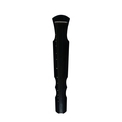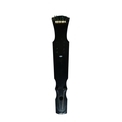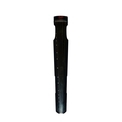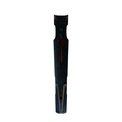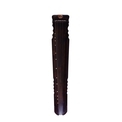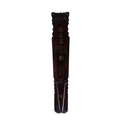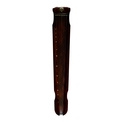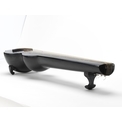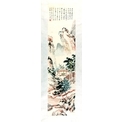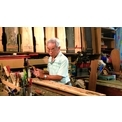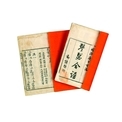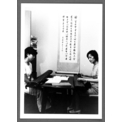Reformed Qin in Zhongni Style (1)
This qin is the product of the musical instrument reforms carried out in mainland China in the 1950s and 1960s. It bears the following characteristics:1. The body is enlarged to increase amplitude of the sound.
2. In addition to the two feet, five wooden knobs have been added to the tail at the bottom. Since each foot or knob is tied to only one string, other strings will not be disturbed during replacement.
3. The traditional tuning pegs system is replaced by a metal tuning machine.
This qin was acquired by Lau Chor-wah. The photo shows the front of the reformed qin in Zhongni style.
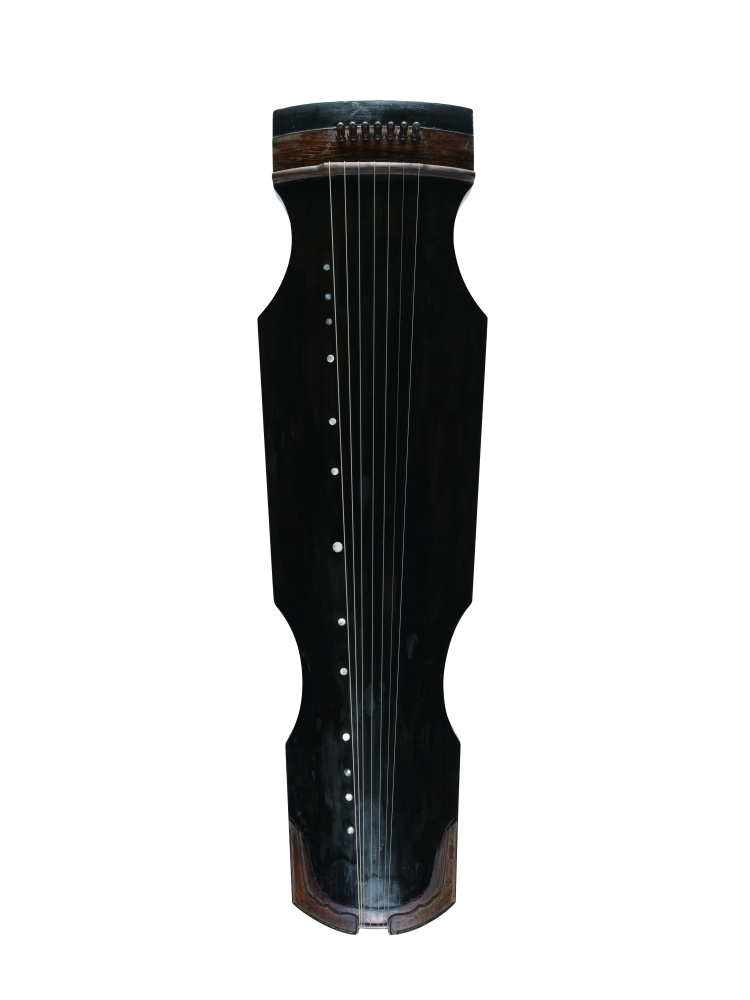
| Date | 1950s-1960s |
| Object | Musical instrument |
| Material Type | Image |
| Collection | The Legend of Silk and Wood: A Hong Kong Qin Story |
| Source | Courtesy of Lau Chor-wah |
| Repository | Lau Chor-wah |
| Note to Copyright | Permission for use in Hong Kong Memory is given by Lau Chor-wah |
| Accession No. | lcs-hkqs-0016 |
Reformed Qin in Zhongni Style (1)
This qin is the product of the musical instrument reforms carried out in mainland China in the 1950s and 1960s. It bears the following characteristics:1. The body is enlarged to increase amplitude of the sound.
2. In addition to the two feet, five wooden knobs have been added to the tail at the bottom. Since each foot or knob is tied to only one string, other strings will not be disturbed during replacement.
3. The traditional tuning pegs system is replaced by a metal tuning machine.
This qin was acquired by Lau Chor-wah. The photo shows the front of the reformed qin in Zhongni style.

| Date | 1950s-1960s |
| Style | Zhongni |
| Size | Length (Whole 124.5cm, Strings 111cm); Width (Forehead 31cm, Shoulder 35 cm, Tail 25cm); Thickness 7cm |
| Weight | 4.7kg |
| Object | Musical instrument |
| Material Type | Image |
| Collection | The Legend of Silk and Wood: A Hong Kong Qin Story |
| Source | Courtesy of Lau Chor-wah |
| Repository | Lau Chor-wah |
| Note to Copyright | Permission for use in Hong Kong Memory is given by Lau Chor-wah |
| Accession No. | lcs-hkqs-0016 |
Reformed Qin in Zhongni Style (1)
This qin is the product of the musical instrument reforms carried out in mainland China in the 1950s and 1960s. It bears the following characteristics:1. The body is enlarged to increase amplitude of the sound.
2. In addition to the two feet, five wooden knobs have been added to the tail at the bottom. Since each foot or knob is tied to only one string, other strings will not be disturbed during replacement.
3. The traditional tuning pegs system is replaced by a metal tuning machine.
This qin was acquired by Lau Chor-wah. The photo shows the front of the reformed qin in Zhongni style.

| Date | 1950s-1960s |
| Object | Musical instrument |
| Material Type | Image |
| Collection | The Legend of Silk and Wood: A Hong Kong Qin Story |
| Source | Courtesy of Lau Chor-wah |
| Repository | Lau Chor-wah |
| Note to Copyright | Permission for use in Hong Kong Memory is given by Lau Chor-wah |
| Accession No. | lcs-hkqs-0016 |
Reformed Qin in Zhongni Style (1)
This qin is the product of the musical instrument reforms carried out in mainland China in the 1950s and 1960s. It bears the following characteristics:1. The body is enlarged to increase amplitude of the sound.
2. In addition to the two feet, five wooden knobs have been added to the tail at the bottom. Since each foot or knob is tied to only one string, other strings will not be disturbed during replacement.
3. The traditional tuning pegs system is replaced by a metal tuning machine.
This qin was acquired by Lau Chor-wah. The photo shows the front of the reformed qin in Zhongni style.

| Date | 1950s-1960s |
| Object | Musical instrument |
| Material Type | Image |
| Collection | The Legend of Silk and Wood: A Hong Kong Qin Story |
| Source | Courtesy of Lau Chor-wah |
| Repository | Lau Chor-wah |
| Note to Copyright | Permission for use in Hong Kong Memory is given by Lau Chor-wah |
| Accession No. | lcs-hkqs-0016 |
Reformed Qin in Zhongni Style (1)
This qin is the product of the musical instrument reforms carried out in mainland China in the 1950s and 1960s. It bears the following characteristics:1. The body is enlarged to increase amplitude of the sound.
2. In addition to the two feet, five wooden knobs have been added to the tail at the bottom. Since each foot or knob is tied to only one string, other strings will not be disturbed during replacement.
3. The traditional tuning pegs system is replaced by a metal tuning machine.
This qin was acquired by Lau Chor-wah. The photo shows the front of the reformed qin in Zhongni style.

| Date | 1950s-1960s |
| Object | Musical instrument |
| Material Type | Image |
| Collection | The Legend of Silk and Wood: A Hong Kong Qin Story |
| Source | Courtesy of Lau Chor-wah |
| Repository | Lau Chor-wah |
| Note to Copyright | Permission for use in Hong Kong Memory is given by Lau Chor-wah |
| Accession No. | lcs-hkqs-0016 |
Reformed Qin in Zhongni Style (1)
This qin is the product of the musical instrument reforms carried out in mainland China in the 1950s and 1960s. It bears the following characteristics:1. The body is enlarged to increase amplitude of the sound.
2. In addition to the two feet, five wooden knobs have been added to the tail at the bottom. Since each foot or knob is tied to only one string, other strings will not be disturbed during replacement.
3. The traditional tuning pegs system is replaced by a metal tuning machine.
This qin was acquired by Lau Chor-wah. The photo shows the front of the reformed qin in Zhongni style.

| Date | 1950s-1960s |
| Object | Musical instrument |
| Material Type | Image |
| Collection | The Legend of Silk and Wood: A Hong Kong Qin Story |
| Source | Courtesy of Lau Chor-wah |
| Repository | Lau Chor-wah |
| Note to Copyright | Permission for use in Hong Kong Memory is given by Lau Chor-wah |
| Accession No. | lcs-hkqs-0016 |
Reformed Qin in Zhongni Style (1)
This qin is the product of the musical instrument reforms carried out in mainland China in the 1950s and 1960s. It bears the following characteristics:1. The body is enlarged to increase amplitude of the sound.
2. In addition to the two feet, five wooden knobs have been added to the tail at the bottom. Since each foot or knob is tied to only one string, other strings will not be disturbed during replacement.
3. The traditional tuning pegs system is replaced by a metal tuning machine.
This qin was acquired by Lau Chor-wah. The photo shows the front of the reformed qin in Zhongni style.

| Date | 1950s-1960s |
| Object | Musical instrument |
| Material Type | Image |
| Collection | The Legend of Silk and Wood: A Hong Kong Qin Story |
| Source | Courtesy of Lau Chor-wah |
| Repository | Lau Chor-wah |
| Note to Copyright | Permission for use in Hong Kong Memory is given by Lau Chor-wah |
| Accession No. | lcs-hkqs-0016 |
Reformed Qin in Zhongni Style (1)
This qin is the product of the musical instrument reforms carried out in mainland China in the 1950s and 1960s. It bears the following characteristics:1. The body is enlarged to increase amplitude of the sound.
2. In addition to the two feet, five wooden knobs have been added to the tail at the bottom. Since each foot or knob is tied to only one string, other strings will not be disturbed during replacement.
3. The traditional tuning pegs system is replaced by a metal tuning machine.
This qin was acquired by Lau Chor-wah. The photo shows the front of the reformed qin in Zhongni style.

| Date of Death | 1950s-1960s |
| Object | Musical instrument |
| Material Type | Image |
| Collection | The Legend of Silk and Wood: A Hong Kong Qin Story |
| Source | Courtesy of Lau Chor-wah |
| Repository | Lau Chor-wah |
| Note to Copyright | Permission for use in Hong Kong Memory is given by Lau Chor-wah |
| Accession No. | lcs-hkqs-0016 |
Reformed Qin in Zhongni Style (1)
This qin is the product of the musical instrument reforms carried out in mainland China in the 1950s and 1960s. It bears the following characteristics:1. The body is enlarged to increase amplitude of the sound.
2. In addition to the two feet, five wooden knobs have been added to the tail at the bottom. Since each foot or knob is tied to only one string, other strings will not be disturbed during replacement.
3. The traditional tuning pegs system is replaced by a metal tuning machine.
This qin was acquired by Lau Chor-wah. The photo shows the front of the reformed qin in Zhongni style.

| Date | 1950s-1960s |
| Material Type | Image |
| Collection | The Legend of Silk and Wood: A Hong Kong Qin Story |
| Source | Courtesy of Lau Chor-wah |
| Note to Copyright | Permission for use in Hong Kong Memory is given by Lau Chor-wah |
| Accession No. | lcs-hkqs-0016 |
Reformed Qin in Zhongni Style (1)
This qin is the product of the musical instrument reforms carried out in mainland China in the 1950s and 1960s. It bears the following characteristics:1. The body is enlarged to increase amplitude of the sound.
2. In addition to the two feet, five wooden knobs have been added to the tail at the bottom. Since each foot or knob is tied to only one string, other strings will not be disturbed during replacement.
3. The traditional tuning pegs system is replaced by a metal tuning machine.
This qin was acquired by Lau Chor-wah. The photo shows the front of the reformed qin in Zhongni style.

| Date | 1950s-1960s |
| Material Type | Image |
| Object | Musical instrument |
| Collection | The Legend of Silk and Wood: A Hong Kong Qin Story |
| Source | Courtesy of Lau Chor-wah |
| Repository | Lau Chor-wah |
| Note to Copyright | Permission for use in Hong Kong Memory is given by Lau Chor-wah |
| Accession No. | lcs-hkqs-0016 |
Copyright © 2012 Hong Kong Memory


